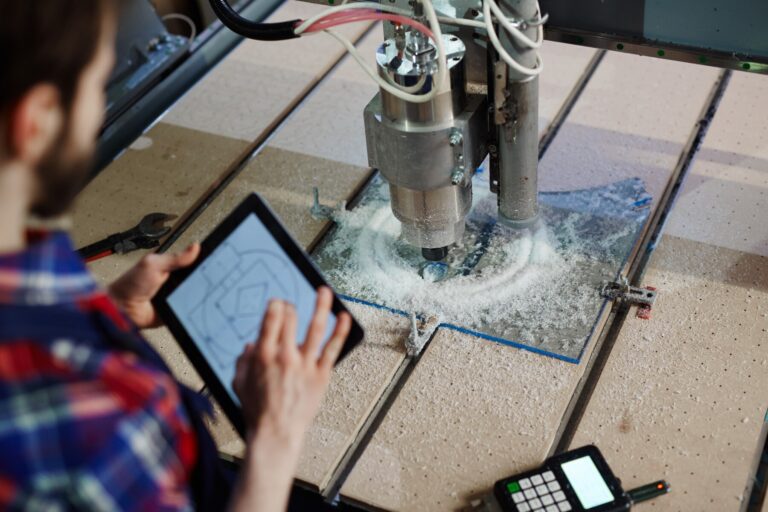5-axis CNC machining is a transformative technology in the manufacturing industry, enabling the production of complex parts with high precision and efficiency. However, like any advanced technology, it presents unique challenges that can affect productivity, accuracy, and consistency. In this article, we’ll explore common challenges in 5-axis CNC machining and offer solutions to overcome them, so manufacturers can maximize the benefits of this sophisticated equipment.
Tool Deflection and Wear in 5-Axis CNC Machining
Tool deflection and wear are common issues in 5-axis CNC machining due to the high-speed, multi-directional movement of the cutting tool. When the tool deflects under stress, it can compromise the part’s accuracy, leading to errors in dimensions and surface finish. Additionally, continuous cutting can accelerate tool wear, reducing tool life and causing frequent downtime for replacements.
To mitigate tool deflection, it’s essential to select high-quality tools designed for 5-axis operations and monitor cutting parameters. Using rigid tool holders and optimizing cutting speeds can reduce the stress on the tool. Regular maintenance and tool change schedules will also help to minimize wear and keep the machine running smoothly, maintaining high precision throughout the machining process.
Complex Setup and Alignment Requirements
The setup process for 5-axis CNC machining is inherently more complex than for 3-axis systems. Operators must align multiple axes precisely to ensure that the machine can make accurate cuts at the desired angles. Improper setup can result in misalignments that lead to part inaccuracies, additional machining time, and material waste.
Using specialized software to simulate and test the setup before actual machining can be an effective solution. Many CAD/CAM programs offer advanced features for virtual simulation, allowing operators to identify potential issues with alignment and axis orientation before starting the process. Additionally, investing in quality fixture systems that maintain tight tolerances can simplify setup and improve alignment accuracy, reducing time and errors.
Collision Avoidance in Multi-Axis Movements
In 5-axis CNC machining, the tool and workpiece rotate and move simultaneously, creating a higher risk of collision, especially when machining complex geometries. Collisions can damage both the machine and the part, leading to costly repairs and material waste. Preventing collisions in a multi-axis environment requires careful planning and advanced programming.
To avoid collisions, operators can use simulation software to visualize and analyze the toolpath before machining begins. This allows them to detect potential collision points and adjust the program accordingly. Employing collision-detection systems within the CNC software can also provide real-time monitoring and warnings, helping to avoid unexpected accidents during machining.
Managing Thermal Effects for Precision
Thermal effects, caused by the heat generated during cutting, are a common challenge in 5-axis CNC machining, affecting the precision and quality of the machined part. Excessive heat can lead to thermal expansion, distorting the material and reducing dimensional accuracy. This issue becomes particularly problematic when machining materials with high thermal sensitivity.
To manage thermal effects, implementing effective cooling techniques, such as flood coolant or mist lubrication, can help dissipate heat. Monitoring the temperature of both the tool and the workpiece is also essential; modern CNC machines often include temperature control systems to ensure optimal conditions. Additionally, selecting the appropriate cutting speed, feed rate, and tool material based on the thermal properties of the workpiece can further help in minimizing thermal expansion issues.
Maintaining Surface Finish Quality
Achieving a high-quality surface finish is crucial in 5-axis CNC machining, particularly in industries where precision and aesthetics are paramount. However, multiple axes and complex tool paths can sometimes result in chatter, tool marks, and inconsistent finishes, which diminish the part’s overall quality. Surface finish challenges can be due to factors such as tool selection, vibration, and incorrect machining parameters.
To improve surface finish, operators should carefully select cutting tools suited for the material and application. Reducing feed rates and optimizing spindle speeds can help minimize vibration and chatter, resulting in smoother surfaces. Additionally, using post-process treatments, such as polishing or buffing, can further enhance surface quality if machining alone does not achieve the desired finish.
Conclusion
5-axis CNC machining offers unparalleled flexibility and precision in manufacturing, allowing for the production of intricate parts with complex geometries. However, the technology comes with unique challenges, from tool deflection and thermal effects to collision risks and setup complexity. By implementing these solutions, manufacturers can address the obstacles and unlock the full potential of 5-axis CNC machining, improving accuracy, productivity, and part quality in their operations.

